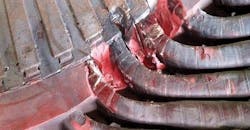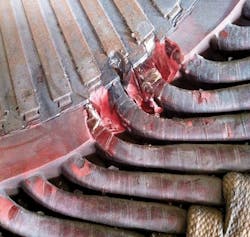The Value of Partial Discharge Detection
Partial discharge (PD) is defined as a localized, high-frequency arcing that only partially bridges the insulation between multiple conductors or between conductors and the ground wall of an electrical apparatus. It can occur in many system components, such as capacitors, cables, switchgear, transformers, generators, and motors. PD is the result of an electrical breakdown that can occur across the surface or within gas-filled voids in the insulation, causing the ionization of the gas in and around the insulation.
Contributors to PD include voltage stress from phenomena such as voltage spikes caused by the opening and closing of the contactors during startup and shutdown. Voltage transients are caused by the switching frequencies from variable-frequency drives (VFDs) in combination with poor lamination, improper insulation impregnation, and contamination. Voltage transients of two to three times line voltage are very common, and four to five times line voltages are real. While transients caused by the opening and closing of contactors can be mitigated by the use of soft starts and VFDs, transients can also be caused by the fast switching frequencies of the drives as defined by V=L × (di÷dt).
Harmful Effects of Partial Discharge
PD occurring in the stator of an electric motor can damage winding insulation and contribute to significantly accelerated aging of the insulation, which can be compounded by a number of other conditions, such as carbon tracking, corona, and the production of ozone gas (O3).
Corona is the physical manifestation of a PD and appears as a faint glowing light that surrounds a conductor at high potential. This is a common occurrence in motors with operating voltages above 5,500V, and methods of dealing with corona discharge in these larger motors have been heavily researched and developed over the years. “Conductive tapes are used as a conductive layer on the coil slot portion to reduce corona discharges that can occur on the coil surfaces. Semi-conductive corona protection tapes are used on the coils at the slot exit region and prevents surface discharges at these locations. The use of these commercially available tapes on high-voltage coils that are processed using the vacuum pressure impregnation (VPI) method, has been developed.” (IEEE, 1995)
Another symptom of PD is the production of ozone gas. When PD occurs, it ionizes the air around the insulation, producing ozone gas. O3 is an unstable gas that is colorless, toxic, and has a strong odor/powerful oxidizing properties that can be harmful to both conductors and the insulation inside a motor. A motor that exhibits high levels of PD and corona can cause the area around it to smell strongly of this gas.
Partial Discharge Detection
Partial discharge detection (PDD) in electric motors can be broken down into two main categories: online and offline testing. Online motor testing refers to any testing that is conducted while a motor is powered on and running. Offline testing describes any testing that is performed while a motor is de-energized and disconnected from an active power source. Some methods of detecting PD include:
• Acoustic detection (online): Involves the use of microphones to pick up the high-frequency emissions projected by the PDs.
• Radio frequency (online): Refers to the use of patch antennae to detect electromagnetic radiation (EM) given off during a PD.
• High-frequency current transformers (online): HFCTs are often installed on larger, medium- and high-voltage motors to convert the high-frequency waveform components that are indicative of PD into measurable voltage signals.
• Ultrasonic.
• Capacitive coupling (online): Uses high-voltage capacitors to filter the PD electrical information out to a detection system.
• Traditional electrical measurement.
• Resistive division (offline): The process of attenuating and then filtering an impulse waveform to isolate the high-frequency PD components for detection and analysis. This type of detection can be performed during surge testing of both individual coils and assembled stators. The resistive division method has many benefits over other detection methods, such as repeatable, accurate measurements, and it provides a much wider bandwidth for PD detection than other detection methods.
PD on Surge
The resistive division method of attenuation and filtering is unique from other detection methods because the data is collected during surge testing while the motor is offline. This method is referred to as “PD on Surge.” There are a number of terms that are unique to this detection method and important to understand because they help to quantify and describe the PD activity that is occurring in any given motor.
• PD event: Frequency component within the PD detection spectrum that exceeds a user-defined magnitude threshold (mV).
• PD pulse: Surge pulse containing more than a minimum number of PD events. The minimum value is set to mitigate false positives that may arise from noise artifacts or surge pulse components that may appear within the detection spectrum.
• PD inception voltage (PDIV): The voltage level at which PDs greater than the threshold initially occur.
• Repetitive PD inception voltage (RPDIV): The voltage level at which PD greater than the threshold occurs for >50% of surge pulses.
• Repetitive PD extinction voltage (RPDEV): The voltage level at which PD occurs for <50% of surge pulses.
• PD extinction voltage (PDEV): The voltage level at which PDs no longer occur.
PD on Surge vs. Test Coil Method
The “test coil method,” as is oftentimes used in many rewind shops as a means to verify the penetration of varnish during the vacuum pressure impregnation (VPI) process, has been the only means available to detect voids or other imperfections in the insulation. This process involves the creation of a wooden “slot” and an extra form coil that is inserted into the slot and placed inside the stator during the VPI process.
The idea behind this method is that the test coil is going to be an accurate representation of all of the other coils in the stator. Although this method has been used as a tool to get an idea of the varnish penetration, there are some pitfalls that can be overcome by using PDD during surge testing of the stator.
The test coil method wastes both time and materials. While a single coil may not seem like much, it does require both material and the time spent by the winder to build, both of which are an added expense to the shop and ultimately the customer. More importantly, the test coil, while a representative sample of the VPI process, still gives no direct analysis of the coils in the stator. It is not a true assessment of the penetration in the actual windings of the motor. It does not detect voids throughout the entire assembly. PDD can be performed during surge testing of the stator, both before and after
the VPI process, requiring no excess materials and virtually no extra time by motor shop personnel to accurately verify the integrity of the varnish penetration — and, consequently, the quality of the insulation of the windings of the stator.
Random Wind Shops
PDD should be used as a quality verification of the rewind process by identifying the presence of voids in the insulation that may otherwise go unnoticed. While surge testing has become widely accepted as the best method for detecting copper to copper insulation weakness and shorts, the addition of PDD enhances the surge test to also include the ability to detect and quantify the PD activity that is indicative of other issues with the insulation such as voids and improper varnish impregnation.
PDD can also be used as an evaluation of the current state of PD activity in a random winding that has experienced a long service life but does not require rewind by providing additional information regarding the internal state of the insulation.
Reliability Services
While the majority of this discussion focuses on the benefits of PDD to electric motor repair shops, it is certainly worth mentioning that it can also be a useful tool for reliability and maintenance personnel. PD detection allows predictive maintenance professionals to establish baseline levels of PD to aid in the predictive indication of the condition and health of large and critical motors.
This baseline testing then allows for continued trending of the inception and extinction voltages as well as the amount of PD that is occurring and at what voltages. This additional diagnostic information provides the maintenance team an opportunity to prepare for and address impending motor failures as early as possible.
PDD is an excellent tool that can be used to indicate the condition and health of the electrical insulation of the windings of a motor. Detecting PD during surge testing can be especially helpful to motor repair shops to
ascertain the health of the winding insulation of the motors they evaluate and repair.
Coombs works for Baker Instruments, a division of Megger, in Fort Collins, Colo. He can be reached at [email protected].
SIDEBAR: Applicable Standards
There are a number of standards that govern partial discharge (PD) testing.
IEC 60270:
• High Voltage Test Techniques – Partial Discharge Measurements
• Primarily concerned with AC and DC measurements of PD
IEC 61934:
• Electrical Insulating Materials and Systems
• Specifically developed to provide guidance on surge impulse PD detection
IEC 60034:
• References both IEC 61934 and IEC 60270
IEEE 927:
• IEEE Guide for the measurement of Partial Discharges in AC Machinery
• Discussion of both online and offline techniques

